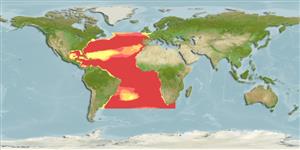Common names from other countries
>
Myctophiformes (Lanternfishes) >
Myctophidae (Lanternfishes) > Diaphinae
Etymology: Diaphus: Greek, dis, dia = through + Greek, physa, phyo = to beget, to have as offspring (Ref. 45335).
More on author: Bleeker.
Environment: milieu / climate zone / depth range / distribution range
Ecologie
marien; oceanodroom (Ref. 51243); diepte 0 - 805 m (Ref. 13608), usually 450 - 500 m (Ref. 4775). Subtropical; 51°N - 40°S
Eastern Atlantic: Canary Islands (Ref. 6808), 20°N (inshore from 29°N) to about 10°S west of 0°, with disjunct distribution between 14°N and 8°N, but to 23°S east of 0°. Isolates north to off south-west Ireland (Ref. 4775). Western Atlantic: tropical areas but with expatriate extensions to 51°N and 45°S in western boundary currents [(apparently absent over a minimum region off Brazil) according to Ref. 4479 or 4775] (Ref. 4479, 4775). Very rare or absent in the Indo-Pacific.
Tropical Indian and Atlantic; east coast of South America (Ref. 47377).
Lengte bij maturiteit / Grootte / Gewicht / Leeftijd
Maturity: Lm 5.2 range ? - ? cm
Max length : 9.5 cm TL mannelijk / geslacht onbekend; (Ref. 40727); max. gerapporteerde leeftijd: 1.00 Jaren (Ref. 4882)
Korte beschrijving
Determinatiesleutels | Morfologie | Morfometrie
Dorsale stekels (totaal) : 0; Dorsale zachte stralen (totaal) : 14 - 15; Anale stekels: 0; Anale zachte stralen: 14 - 15.
High-oceanic and mesopelagic populations are found between 225-750 m during the day (maximum abundance at 450-500 m) and is nyctoepipelagic at surface down to 125 m at night (Ref. 4479). Pseudoceanic and pelagic populations are found in the upper 50 m at night (Ref. 4066). Feeding is acyclic in northwest Africa (Ref. 9198).
Levenscyclus en paargedrag
Maturities | Voortplanting | Spawnings | Egg(s) | Fecundities | Larven
Hulley, P.A., 1990. Myctophidae. p. 398-467. In J.C. Quero, J.C. Hureau, C. Karrer, A. Post and L. Saldanha (eds.) Check-list of the fishes of the eastern tropical Atlantic (CLOFETA). JNICT, Lisbon; SEI; Paris; and UNESCO, Paris. Vol. 1. (Ref. 4479)
Status op de Rode Lijst van het IUCN (Ref. 130435)
CITES (Ref. 128078)
Not Evaluated
Gevaar voor de mens
Harmless
Gebruik door de mens
Tools
Speciale rapporten
Download XML
Internetbronnen
Estimates based on models
Preferred temperature (Ref.
115969): 6.5 - 13.9, mean 9.6 (based on 46 cells).
Fylogenetische diversiteitsindex (Ref.
82804): PD
50 = 0.5000 [Uniqueness, from 0.5 = low to 2.0 = high].
Bayesian length-weight: a=0.00741 (0.00455 - 0.01207), b=3.00 (2.86 - 3.14), in cm Total Length, based on LWR estimates for this species & Genus-body shape (Ref.
93245).
Trofisch niveau (Ref.
69278): 3.0 ±0.00 se; based on food items.
Weerstandsvermogen (Ref.
120179): Hoog, minimale populatieverdubbelingstijd minder dan 15 maanden (K=1.83-3.81; tm=0.7; tmax=1.2).
Fishing Vulnerability (Ref.
59153): Low vulnerability (10 of 100).
